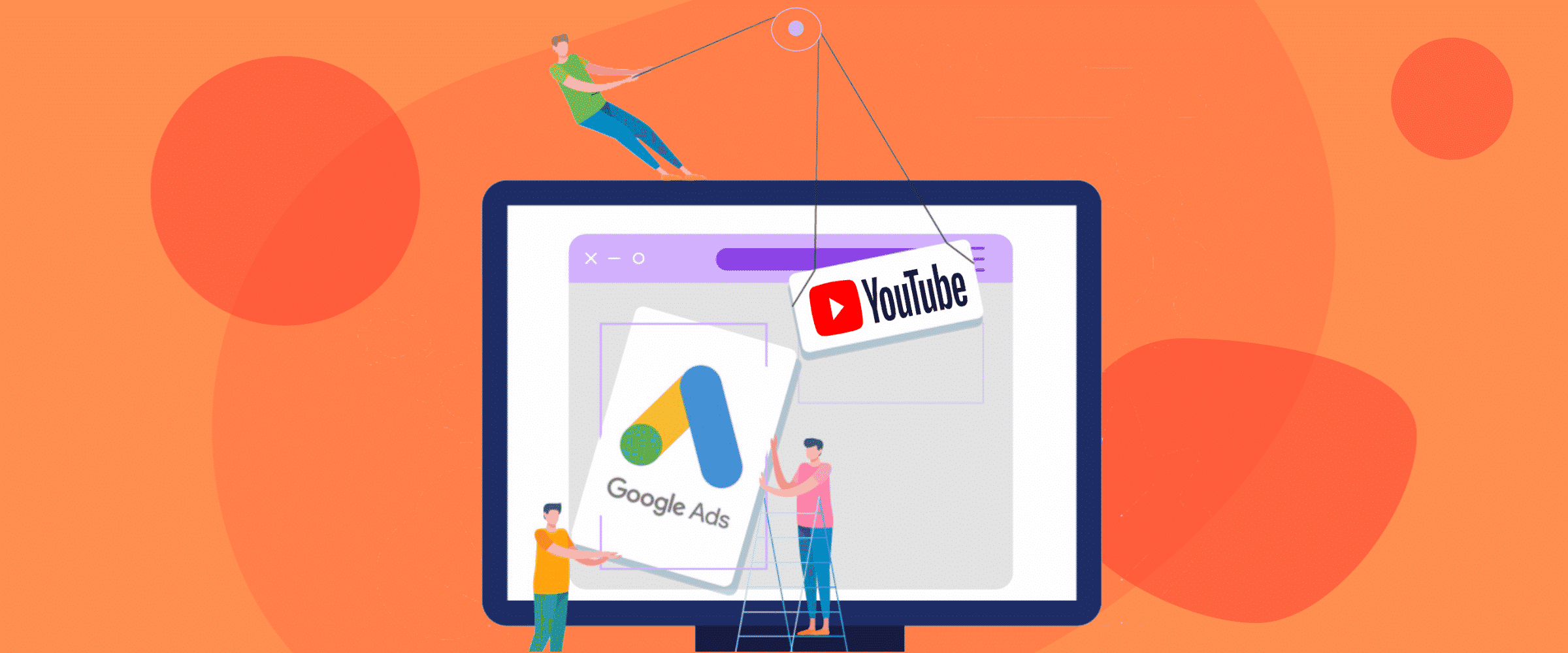Hello!
YouTube has taken over! The average person spends 1-2 hours a day here. It’s the go-to source for news, entertainment, education and engaging withbrands like yours online.
 Your audience finds videos by subscribing to your YouTube channel, searching with keywords, viewing topic-based recommendations, clicking ads, and arriving through organic sharing and Display Network ads.
Your audience finds videos by subscribing to your YouTube channel, searching with keywords, viewing topic-based recommendations, clicking ads, and arriving through organic sharing and Display Network ads.
However they reach you, they’re here to engage. Learn. And buy what you’re selling.
Tap into this engagement with Google ads for YouTube. We’ll show you how to advertise on YouTube the right way.
What You’ll Learn About YouTube Google Ads Here
Tapping into this audience isn’t automatic. You need a plan to reach the right people quickly and cost-effectively.
We’ll cover everything you need to know to be successful with Google Ads for YouTube.
What Are YouTube Ads?
YouTube ads appear across the YouTube platform, on the Display Network (Google’s partner websites), or in Google search results. They see your ads on their YouTube home page and YouTube search results. But most noticeably, your audience sees them before, during, and after a video they’re watching.
 These ads come in some basic YouTube ad formats, like:
These ads come in some basic YouTube ad formats, like:
- Video ads (like a TV commercial but better, because they’re clickable)
- Banner ads
- [AD] boxes… YouTube’s take on [Sponsored]
In this guide, we’ll focus primarily on video ads because, honestly, that’s where you’re more likely to struggle. And the struggle is real.
This guide will have you smooth sailing in no time.
How Do YouTube Google Ads Fit into My Marketing Strategy?
You’re managing a lot of marketing branches. So, where do YouTube Google Ads fit in?

- Brand awareness
- Consideration / Lead Gen
- Decision-making / Sales Enablement
- Onboarding
- Troubleshooting and customer support
You can use them to make quick sales for direct-to-consumer DTC marketing and generate demand for B2C. YouTube ads can even play the long game, communicating a consistent narrative to multiple company decision-makers over months… or years in B2B marketing.
How Are Google and YouTube Related?
Google bought YouTube a “few” years ago (goodness, almost 20 years at this point). So, it’s no secret that Google prefers YouTube as a video platform. Many search results favor YouTube videos over more traditional blog content.
That means starting a YouTube channel and using Google Ads for YouTube is integral to your ROI-focused search engine marketing strategy and broader inbound marketing strategy.
 Google’s vast network also includes:
Google’s vast network also includes:
- Gmail
- Chrome
- Android
- Google apps
- Video Partners on the Display Network (Websites that sell ad space to Google)
- Google Analytics
That’s just to name a few. Google is an omnipresent fixture in the everyday lives of many people.
Google claims about 95% of the online search market and around 71% of the mobile market, thanks to its acquisition of Android.
You would need to live under a rock at the bottom of the ocean that a whale is sleeping upon to escape using a Google product.
Hey, you could be as clueless as these ocean dwellers.
As a result of all of this data collection, Google has some of the most intimate insights into what makes you tick.
 Google knows where you are right now, what you’re doing, and if you skipped lunch. Google: “Time to rev up the In-N-Out ads. You will be eating a burger today!” Google uses this vast knowledge to maximize its revenues.
Google knows where you are right now, what you’re doing, and if you skipped lunch. Google: “Time to rev up the In-N-Out ads. You will be eating a burger today!” Google uses this vast knowledge to maximize its revenues.
When you create Google Ads for YouTube, you’re paying for a piece of this pie that Google baked using your audience’s (and your) data as the ingredients.
Mmmm. Data pie.
How Does YouTube Advertising Work?
Good news. You don’t have to learn a whole new ad platform if you already run Google Ads. You’ll manage it all through your Google Ads Account. And you’ll create a YouTube channel to host your video ads.
What You’ll Need to Get Started.
- YouTube Account
- Google Ads Account
You can link your Google Ads to YouTube.
And if you don’t have a Google Ads account, you can create one from YouTube. Once connected, Google can access your YouTube videos to serve up for video ad campaigns.
If you don’t have a YouTube account, you’ll set one up from YouTube.com.
What Equipment Do I Need to Make Videos?
You don’t need expensive equipment to make quality YouTube videos anymore.
That means you’ll have more to spend on ads.
 All you need is:
All you need is:
- A decent video camera like the one on most smartphones.
- A teleprompter app (optional). It’s nice to have. Paper and pen will work, too!
- Video editing software because Bonody’s Prefect. Or maybe you nail it on the first take. And you’re just that good — no editing software required.
Google YouTube Ad Types & How to Use Them
You have many options when setting up Google Ads for YouTube. Each of these ad formats can help you meet YouTube marketing goals in its own way.
Skippable In-Stream Ads
A skippable in-stream ad appears before or during a video in full-screen. The viewer can skip them after 5 seconds. So, it must be at least 5 seconds long and up to 3 minutes (ideally no more).
 As you can imagine, those first 5 seconds are critical. Intrigue a viewer, and they may just keep watching.
As you can imagine, those first 5 seconds are critical. Intrigue a viewer, and they may just keep watching.
Or, in a best-case scenario, they’ve seen what they needed to see. They hit your CTA button right away. Now, you may think of a skipped ad as a missed opportunity. Here’s why that’s all wrong: First, the banner remains on the page. They can still click.
Second, you’re generating brand awareness. You’ve just spent 5 seconds on their screen. That’s like 10 years in Internet time.
Third, hitting skip is engagement. From a marketing psychology perspective, even a “negative” engagement helps them remember you.
And finally, we’ll contradict ourselves entirely and say this. Skipping isn’t a negative. People feel positive emotions when they get to choose how they engage with your brand.
Non-Skippable In-Stream Video Ads
 A non-skippable ad forces the viewer to watch at least 30 seconds of your ad before, during, or after the video. Then, they can skip. And these can be 15-30 minutes if you’re bold enough to think you can keep their attention.
A non-skippable ad forces the viewer to watch at least 30 seconds of your ad before, during, or after the video. Then, they can skip. And these can be 15-30 minutes if you’re bold enough to think you can keep their attention.
Forcing someone to sit through 30 seconds has greater risk and reward.
You could leave them feeling like they just lost 30 seconds of their life that they can never get back.
Or you can ensure that 30 seconds feels well-spent for your audience.
Bumper Ads
Bumper ads are full-screen video ads that last up to 6 seconds and can’t be skipped. These ads play before a video the viewer has chosen to watch.
Quick and to the point, they can be very effective for repeating your marketing message several times within a short window.
Suggested Video / Video Discovery Ads
 These are a special kind of video ad. They appear in the Google search results, YouTube’s homepage, and video watch page.
These are a special kind of video ad. They appear in the Google search results, YouTube’s homepage, and video watch page.
They’re labeled with [AD] to comply with the Federal Trade Commission’s (FTC) regulations regarding sponsored content.
These ads will include a thumbnail and up to 3 lines of text (usually a long video title). Carefully select both the title and the thumbnail to get people to click on your ad.
These shouldn’t feel like an ad — at all.
Once they’ve clicked on your Discovery Google Ads for YouTube, it’s up to you to show them this was a smart click. Then, get them to the next step based on your goals.
These are pay-per-click (PPC) rather than pay-per-view like many in-stream YouTube Google Ads.
Banner Ads
While not the focus of this tutorial, you’ll want to supplement your video ads with banner ads to maximize the reach and engagement of your video ad campaign.
 These pop up in the middle of videos, taking up 20% of the screen. The viewer can instantly close them if they like. Or they can click the banner to go to the landing page you’ve created for it.
These pop up in the middle of videos, taking up 20% of the screen. The viewer can instantly close them if they like. Or they can click the banner to go to the landing page you’ve created for it.
Given how easy it is to get rid of them, these ads must be hyper-relevant to your audience.
Bidding Strategy for Google Ads for YouTube
Are YouTube Google Ads Pay Per Click?
Like social media ads, you can pay per click (PPC) or view (PPV). How you pay depends on length and placement.
Both have their advantages. Pay-per-view ads are much less expensive than pay-per-click. But without engagement, you run the risk they didn’t actually see or pay attention to the ad.
PPC ads are highly useful in video marketing. If your audience isn’t clicking the ad, you get instant feedback without paying for it.
You’ll need both kinds in your YouTube Google Ads strategy.
How Do I Bid on YouTube Google Ads?
Whether you’re using PPV or PPC, the bidding strategy is similar to other Google Ads. You’ll set a maximum cost-per-view or cost-per-click you’re willing to pay. The Google Ads bidding system will automatically adjust your bid based on competition from other bidders.
 You can set a maximum daily advertising budget. And once that budget is used up, you’re done for the day.
You can set a maximum daily advertising budget. And once that budget is used up, you’re done for the day.
Like other Google ads, higher bids can earn you better placement for YouTube Google Ads.
This placement can swing the results dramatically — especially if you have YouTube ad-savvy competitors who track your ads and adapt their strategies to outrank you.
But know you don’t have to outspend this competitor to win top spots. Google’s ad rank system doesn’t only look at how much you spend.
They care about ad relevance. If YouTube shows irrelevant ads to their viewers, those users will leave YouTube. That’s bad for business.
So, Google considers how “helpful” your content is to those seeing it. This relevance bumps you up the ad rank even if you’re not the highest bidder.
If your ads are very relevant, this can drastically reduce your ad spend vs. your competitors for the same placements.
On the flip side, if you pump out poorly optimized, untargeted video ads, Google will make it harder for you to win the bidding wars — no matter how much you spend. You’ll be paying more for the same ad space.
So, with Google Ads for YouTube, relevance is everything.
 Google has a lot of data to determine how relevant your ads are. Not only can they see how long they watch your video ads and how often they click your CTAs. Google can see their engagement with your YouTube channel and the ad landing page.
Google has a lot of data to determine how relevant your ads are. Not only can they see how long they watch your video ads and how often they click your CTAs. Google can see their engagement with your YouTube channel and the ad landing page.
User experience matters!
Targeting Your Audience on YouTube
You choose what you want to bid on through your YouTube Google Ads account to reach your desired audience.
Targeting by Keywords
Target the terms that people search for. People use these terms when looking for videos directly on YouTube. But they also enter queries in the Google search engine. Target those search results, too!
Like Google search ads, don’t forget to include negative keywords in Google Ads for YouTube. You don’t want your video ads to appear in irrelevant searches.
That will lower your ad relevance and cost you more.
Targeting by Topics
 Your audience on YouTube has a set of topics that they frequently watch. Google knows what these are. It recommends videos based on the topics they view. Position yourself as an authority on a topic to build trust in an industry or niche.
Your audience on YouTube has a set of topics that they frequently watch. Google knows what these are. It recommends videos based on the topics they view. Position yourself as an authority on a topic to build trust in an industry or niche.
Targeting In-Market Audiences
Through their behaviors across Google assets, this audience has demonstrated that they are actively researching something to buy and considering options.
They are in the final stages of the buyer’s journey. If you have used YouTube Google Ads to generate awareness, trust, and affinity, this is an excellent place to seal the deal. You’ll need to start with other targeting methods if you haven’t.
Your video ads could include Pros/Cons, Comparing Features, and Checking Reviews to maximize relevance here.
Targeting an Affinity Audience
So, you know who your audience is. But you don’t know exactly what they want or if they’re in the market.
 Target this audience through their traits, interests, and behaviors online. Use broad appeal videos here. Then, move them into your funnel.
Target this audience through their traits, interests, and behaviors online. Use broad appeal videos here. Then, move them into your funnel.
How they respond to your videos becomes a “qualifier” for whether this is a viable customer.
Targeting a Lookalike Audience
Provide Google with data about your recent conversions. They show your video ad to similar people.
Lookalike audiences can help you reach new likely customers even if you don’t know precisely what your ideal customers have in common.
Retargeting Your Customer Lists
Provide Google with a contact list of leads or customers. Google helps you retarget these individuals through YouTube.
These move people deeper into your sales funnel by leveraging the trust and affinity you’ve built to make the sale.
Google Search Targeting Vs. YouTube Targeting
Google search targets intent. Someone asks a question. They want an answer. And they have an idea about what they’re looking for.
 If you want your YouTube Google Ads to rank in Google search results, you will target intent. You target intent by choosing keywords that represent that intent and excluding those that don’t.
If you want your YouTube Google Ads to rank in Google search results, you will target intent. You target intent by choosing keywords that represent that intent and excluding those that don’t.
For example, “install a dishwasher.” The intent is clear. The searcher wants to know how to do something.
Now, YouTube itself only targets intent in two scenarios.
Someone is searching for a video on the platform (keyword).
And to a lesser degree, with in-market targeting. Google knows they’re in the market (in-market targeting) based on what they’ve been up to. Google combines intent data with behavioral insights to target.
Otherwise, YouTube targets an audience with shared demographics, behaviors, interests, and preferences.
We call this an avatar. So, it’s more like targeting on social media.
 Avatar-targeting is broader. You don’t know what this person wants to do right now. But Google’s algorithms know what they’ve been doing (around the Internet). AI {buzz word alert} tells Google what this person will likely click on based on past behaviors.
Avatar-targeting is broader. You don’t know what this person wants to do right now. But Google’s algorithms know what they’ve been doing (around the Internet). AI {buzz word alert} tells Google what this person will likely click on based on past behaviors.
With intent missing in the equation, you can’t get right down to selling your product. You’ll send them running. Instead, focus on bringing people to the top of your funnel with brand awareness content. Position your brand as a trusted source of truth in the industry.
Once you have their attention and have built a rapport, you can guide them into your funnel. As you do, you develop a greater understanding of what their intent is. Now, you can target intent!
Also read:
- Top 10 Best B2B eCommerce Marketplaces to Watch
- How to Use Content Marketing to Grow Your Business
- Top Product Ideas for Technology-Based Small Businesses
Final Thoughts: YouTube Google Ads
Google Ads for YouTube are a great way to connect with a highly engaged audience to sell your products. But it’s important to play by their rules to get the best results. Now you know how to plan, set up, and track the performance of your YouTube Google Ads.
If you’re looking to scale your Google Ads and maximize revenue on YouTube, reach out to SevenAtoms, a Google Ads agency recognized by Google as a Premier Google Ads partner.
Thank you!
Join us on social media!
See you!






